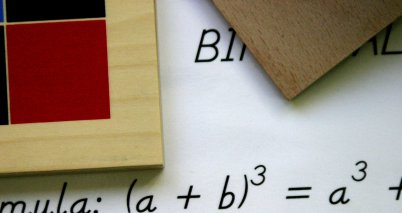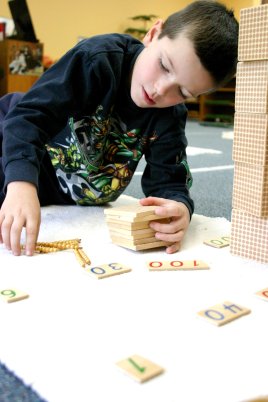This is an age when students have an insatiable thirst for knowledge so the curriculum allows them to explore all aspects of subject matter and aspects of their world. The goal is to allow the students to grow and understand where they fit in to their society and what contribution they can make in the world. Dr. Montessori wanted to show the children the inter-relatedness of all things in the universe such as the furnishing of the earth with plants and animals and the arrival of human beings and their continuing story throughout time. To aid these teachings, she designed five major stories and numerous minor ones which she called the Great Lessons and the "Key Lessons." In this stage of development, Dr. Montessori referred to her approach for elementary children as "Cosmic Education," where the child shows interest in one part of a subject as a starting point for more intensive studies.
Elementary students are divided into two levels: Lower Elementary for six to nine year olds and Upper Elementary for nine to twelve year olds. Materials in the classroom continue to build on the information learned in Children's House and the subject matter expands to include mathematics, geometry, biology, geography, history, language, art and music. There are movable tables and floor mats and no assigned desks. Yet, there are rules and structures to the class that form the children's community and social responsibility to one another. They also go beyond the classroom activities to include "going outs" which is a Montessori term that refers to the students carrying out explorations in society. One of these activities is a one week overnight trip spent at Nature's Classroom Institute in Mukwonago where the children choose groups and lessons to participate in, such as team building and social skills, history, mathematics, science, astronomy, drama, social studies, and language arts. These are hands-on, active lessons in nature. The atmosphere of the classroom is one of freedom with responsibility that gives children a chance to develop self-discipline and healthy social relationships.
Lessons in the Elementary classroom are not bound by the adult's concept of what is useful to know; the teacher is free to follow and build upon the student's own interest. Because there are many small groups of students within the classroom following different lines of activity at any one time, they are simultaneously exposed to a variety of studies. The constant stimulation by the numerous activities and ideas of others around the students accounts for the unusual breadth and depth of knowledge that they ultimately achieve (from Montessori Today by Paula Polk Lillard).
As in the Children's House, there is a
progression in teaching language. One of the "Great Lessons" introduces
the history of language and covers cave paintings, hieroglyphics, telegraph,
radio, satelites, other foreign languages and their roots. The children's
exploration of language includes the study of words, parts of speech and
sentence analysis in order for them to think, write and speak clearly.
Dr. Montessori developed many materials for the children to work with in
a concrete, tangible way for grammar and syntax. Written composition is a
large part of the language work in an elementary classroom. The children write
imaginative, creative compositions as well as factual research reports. The
lessons about the history of written language help to spark interest and
excitement in the children. Some will be inspired to write their own
stories in cursive and illustrate them with pictures, or try other
languages such as the Greek alphabet or Sumerian picture-signs. Spoken
language is encouraged through discussion and debates between classmates,
oral presentations, reading aloud, speeches, and drama. It is a way to
develop exact expression and attention to their choice of words, and to
encourage cooperation in the classroom. Students are allowed to read
books that they choose on their own. They have access to books in the
classroom, school library, and are encouraged to seek further from the
public library. The teacher will present poetry and prose so the students
can study different styles of writing. At this stage of development, the
students are using their reading and writing abilities to expand and
search for the knowledge they want. The students begin to develop their
own intellectual independence and learn the power that words have to
inspire and lift people to heights of achievement as well as learning that
language carries a personal responsibility in the clear expresssion of
themselves and communication with others.
 Mathematics is a subject taught as integrated with others as many rest
on the foundation of math: such as astronomy, chemical formulas, building
foundations, circumference of a wheel, cooking and recipes, etc. Math
began in the Children's House with sensorial
and concrete representations and is continued in
Elementary to introduce the abstract at the
student's individual pace. Dr. Montessorri developed numerous ingenious
math materials and exercises including among others:
Mathematics is a subject taught as integrated with others as many rest
on the foundation of math: such as astronomy, chemical formulas, building
foundations, circumference of a wheel, cooking and recipes, etc. Math
began in the Children's House with sensorial
and concrete representations and is continued in
Elementary to introduce the abstract at the
student's individual pace. Dr. Montessorri developed numerous ingenious
math materials and exercises including among others:

- Number Theory
- Wooden hierarchical materials
- Commutative and distributive laws of multiplication
- Multiples
- Factors
- Measurement
- Operations
- Multiplication on large bead frame, bank game, flat bead frame, checkerboard.
- Long division on racks and tubes, stamp game
- Divisibility
- Squares and Cubes
- Squaring a sum, squaring with hierarchical value
- Cubing a binomial, trinomial and a quadrinomial
- Cubing a number with decimal value
- Fractions
- Introduction
- Adding, subtracting, multiplication and division
- Decimal Fractions
- Presentation of quantity with concrete materials
- Operations with decimal fractions
- Conversion of common fractions to decimal fractions
- Decimal checkerboard
- Leading to abstraction of multiplication of decimal fractions
- Square roots
- Cube roots
- Powers of numbers (2, 10 and other bases)
- Operations using exponential notation
- Expanded power notation
- Word problems
- Signed numbers (positive and negative numbers)
- Bases other than ten
- ratios and proportions
- Introduction to algebra
Excerpts from Know Your School by Carlyn Wagner.
Back to top
